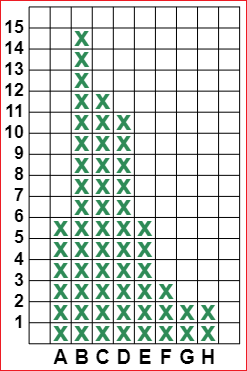
First example / Primo esempio.
The first example, incorporated into the initial version of the program /
Il primo esempio, incorporato nella versione inziale del programma

The three lines in which to insert the inputs / Le tre righe in cui inserire gli input
... nN = 8 // nN [ < 27]: number of freq. contained in N to be considered; I can put in N more than nN values; // the size of the histogram depends on the maximum of the values present in N. N = [ 6, 15, 12, 11, 6, 3, 2, 2] color = "seagreen" // you can change color: "blue" "red" "seagreen" "brown" "magenta" "black" "grey" ...
| Second example / Secondo esempio. What to change to get the histogram on the right / Cosa cambiare per ottenere l'istogramma a destra ... nN = 3 // nN [ < 27]: number of freq. contained in N to be considered; ... // the size of the histogram depends on the maximum of the values present in N. N = [ 9, 8, 6] color = "seagreen" ... | 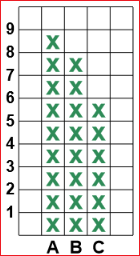 |
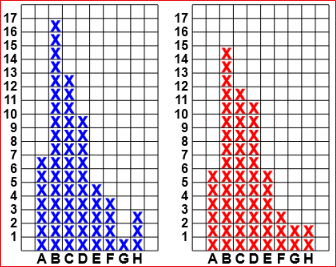 |
Third example / Terzo esempio. How to compare two histograms on the same scale and how to color them differently / Come confrontare nella stessa scala due istogrammi e come colorarli diversamente nN = 8 // nN [ < 27]: number of freq. contained in N to be considered; ... // the size of the histogram depends on the maximum of the values present in N. N = [ 7, 17, 13, 10, 5, 4, 1, 3] color = "blue" nN = 8 // nN [ < 27]: number of freq. contained in N to be considered; ... // the size of the histogram depends on the maximum of the values present in N. N = [ 6, 15, 12, 11, 6, 3, 2, 2, 17] color = "red" |
| Fourth example / Quarto esempio. Another example / Un altro esempio nN = 3 // nN [ < 27]: number of freq. contained in N to be considered; ... // the size of the histogram depends on the maximum of the values present in N. N = [ 9, 8, 6, 18] nN = 3 // nN [ < 27]: number of freq. contained in N to be considered; ... // the size of the histogram depends on the maximum of the values present in N. N = [ 11, 10, 6, 18] nN = 3 // nN [ < 27]: number of freq. contained in N to be considered; ... // the size of the histogram depends on the maximum of the values present in N. N = [ 18, 13, 1] |
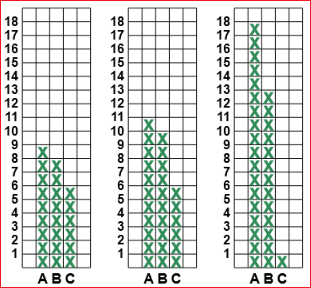 |
Fifth example / Quinto esempio.
At most the frequencies and classes can be 26. For more classes use these scripts /
Al massimo le frequenze e le classi possono essere 26. Per più classi usa questi
script.

... nN = 26 // nN [ < 27]: number of freq. contained in N to be considered; I can put in N more than nN values; // the size of the histogram depends on the maximum of the values present in N. N = [ 1,2,3,4,5,6,7,8,9,10,11,12,13,14,15,16,17,18,19,20,21,22,23,24,25,26] color = "magenta" // you can change color: "blue" "red" "seagreen" "brown" "magenta" "black" "grey" ...
Sixth example / Sesto esempio.
You can change the labels, using the array A. You can insert blank columns. /
Puoi cambiare le etichette, modificando la "array" A. Puoi inserire delle colonne vuote.
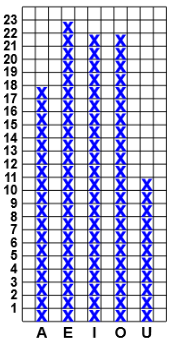 |
The vowels featured in this comic Le vocali presenti in questo fumetto |
... nN = 9 // nN [ < 27]: number of freq. contained in N to be considered; I can put in N more than nN values; // the size of the histogram depends on the maximum of the values present in N. N = [ 18, 0, 23, 0, 22, 0, 22, 0, 11] color = "blue" // you can change color: "blue" "red" "seagreen" "brown" "magenta" "black" "grey" A = ["A","","E","","I","","O","","U"] // You can change A. Then you can put back the original A: // A = ["A","B","C","D","E","F","G","H","I","J","K","L","M","N","O","P","Q","R","S","T","U","V","W","X","Y","Z"] ...